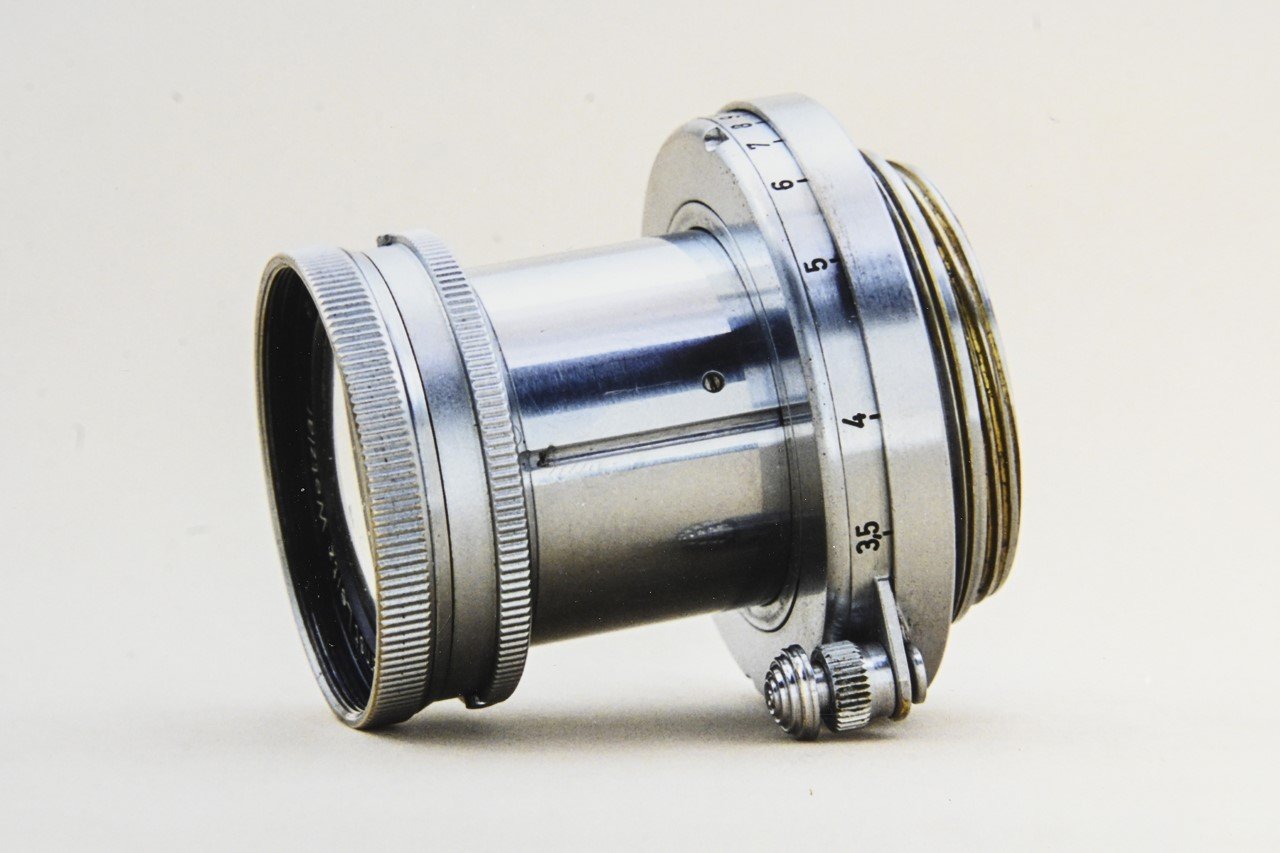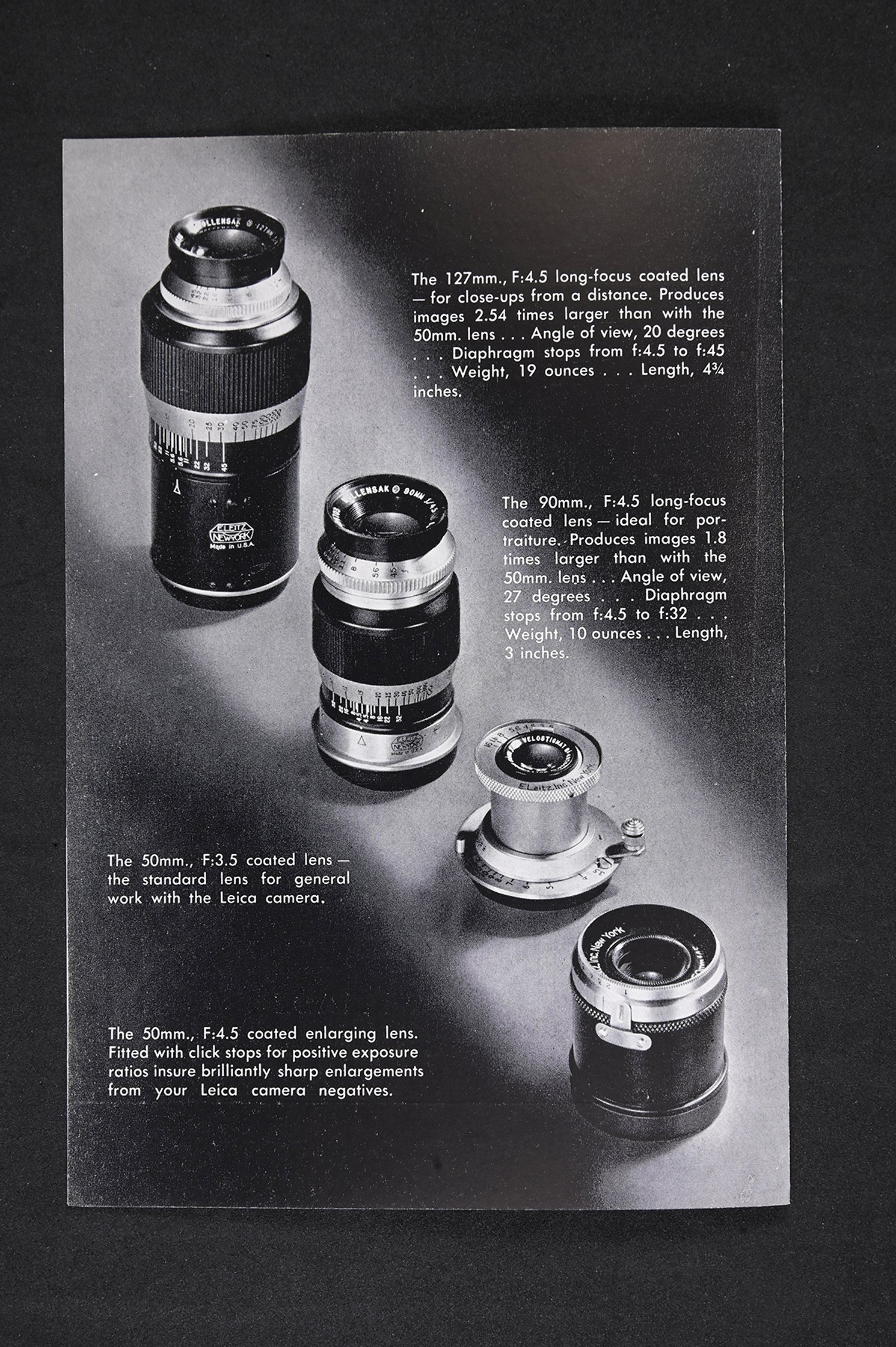Rare and uncommon 50mm Leitz lenses
The unlikely saga of the 50mm normal lens
Even when the Leica was only a promising prototype and its non-interchangeable lens didn’t even have a name, its focal length was (nominally) set at 50mm, a tradition that has continued to the present day. While Leitz was certainly instrumental in helping to establish 50mm as the normal focal length lens for the 24 x 36mm still picture format, the concept really goes back to the pioneer cinematographers of the 1890s, who standardized the 18x24mm motion picture format, and established the 50mm lens as the de facto “normal.” Theoretically, the normal lens for the cine format would be 30mm, the diagonal of the rectangular format that corresponds to the image circle. However, the earliest movies were essentially recordings of stage productions, and using a 50mm moderate telephoto made it easier to confine the coverage to what was happening on the proscenium stage from a convenient shooting distance without including a lot of distracting elements that were off-center. Early 35mm still picture cameras, such as the 1914 Multi-Exposure Simplex Model B, which provided both 18x24mm and 24x36mm formats, used a 50mm (f/3.5 or f/6) normal lens, and Oskar Barnack and countless others followed suit. The enduring irony is that the normal lens for the 24x36mm format should really be closer to the diagonal of the image rectangle, namely 43.27mm, but 50mm has predominated for well over a century.
What’s the rarest interchangeable 50mm lens ever made by Leitz? Easy. In fact, there are two—the 50mm f/3.5 Leitz Anastigmat fitted to the earliest Leica I (Model A) cameras, and its immediate pre-Elmar successor, the 50mm f/3.5 Elmax, named in honor of the great Max Berek, who designed them. Both employ Berek’s idiosyncratic 5-element, 3-group design with a cemented triplet bringing up the rear, and both are said to be a tad sharper in the corners at f/3.5-4 than the iconic 50mm f/3.5 Elmar but a bit lower in overall contrast. The reason they’re exceedingly rare is that Leitz never offered them as interchangeable lenses. They were first offered only as permanently affixed to a Leica I (A). If you can find one in an LTM (screw mount) it means that a Leica I owner had it factory upgraded to Leica II (Model D) or Leica III (Model F) specs, meaning, among other things, that it gained the ability to use interchangeable lenses. In retrospect, leaving their ultra-rare early Leicas intact may have been a better value proposition, but for sheer unobtainable rarity a factory converted 50mm f/3.5 Leitz Anastigmat or Elmax in screw-mount is hard to beat. Your chances of finding one for sale are slim to none, and if you have one, you can name your price.
The Rigid Mount 50mm f/2 Summar
When the 50mm f/2 Leitz Summar was announced in 1932 it was the fastest normal lens for the Leica and it created a sensation among Leica fans who made it a great success. According to Leica-Wiki, Leitz made a total of 127,950 Summars from 1933-1939, all in screw mount, all uncoated, most with 6-bladed apertures to f/12.5, and all based on a classic 6-element, 4-group Gauss design. Of this vast number all were collapsible except for two runs in 1933 of rigid 50mm Summars totaling 1,950 units. Result: You can snag a clean functional collapsible Summar for about 300 bucks (pristine examples and late ones with 10-bladed run $500-$600), but rigid Summars are very thin on the ground and often fetch $1,500 and up if or when you can find one.
The rare 50mm f/2 Summar “Tropen”
Produced in very limited numbers in 1938 as a better sealed lens designed to resist the formation of fungus and other deterioration in hot, humid tropical climates, the collapsible 50mm f/2 Summar “Tropen” is noticeably longer than the standard 50mm f/2 Summar and has a groove in the barrel like the one on the, later (and much improved) 50mm f/2 Summitar. While the standard Summar (Leitz product 42134) has a 6-element design, the Summar Tropen (Leitz product 42214) has 7 elements since the front group is a cemented plano-convex doublet instead of a single freestanding element. Leica historian James Lager conjectures that only about 200-300 Tropen Summars were made. Others assert that the total production was far lower. Whatever the true figure is, you may rest assured that all are super-rare, coveted collector’s items that fetch very fancy prices indeed.
The Rare Rigid 50mm f/2 Summicron in screw mount
When Leitz announced the breakthrough 50mm f/2 Summicron in 1953 it was the collapsible screw-mount version, shortly followed by an M-mount version. In 1956, Leitz unveiled the magnificent Dual-Range Summicron in M-mount, and another rigid M-mount version of the 7-element, 6-group 50mm f/2 Summicron that focused down to a 1 meter. This superb lens was also produced in small quantities in Leica screw mount and is said to be the highest quality screw-mount lens Leica ever made. The rigid screw mount 50mm f/2 Summicron uses the classic 7-element, 6-group formula, has 10 diaphragm blades, focuses down to 1 meter, and weighs in at 8.85 ounces. Used price range: $2,000-$3,500.
The Rare 50mm f/1.4 Leitz Summilux in screw mount
Dating from 1960, the chrome finished 50mm f/1.4 Leitz Summilux in Leica screw mount (code name SOWGE) is a 7-element, 5-group lens with a 10-bladed diaphragm that stops down to f/16, has a minimum focus distance of 1 meter, and weighs in at 11.3 ounces. It is a lovely lens, but this version 1 Summilux was surpassed in overall performance by the version 2 (SOOME) of 1961-1968 in M-mount. Only 568 examples of the 50mm f/1.4 Leitz Summilux in screw mount were produced, making it exceedingly rare. Used price range: $5,500-$6,500.
E.Leitz, NY. 50mm f/3.5 Wollensak Velostigmat in Leica screw mount
When shipments of Leica cameras and lenses from Germany ground to a screeching halt during WWII, the ever-resourceful folks at E. Leitz, New York devised an ingenious workaround—they had a series of 4 Leica screw mount lenses made by the estimable optical firm of Wollensak in Rochester, NY. These included 127mm f/4.5, 90mm f/4.5, and 50mm f/3.5 Wollensak Velostigmat camera lenses and one enlarging lens. The 50mm f/3.5 Velostigmat is a nicely made Elmar clone based on a similar 4-element, 3 group Tessar formula and it purportedly performs on a par with the beloved Elmar. After the end of WWII, Leica cameras and lenses began to trickle in and Leica fans were overjoyed to be able to buy real Leica lenses at 2-3 times the price of the Wollensak stand-ins. Sadly we have no production figures, but today the 50mm f/3.5 Wollensak Velostigmat in LTM mount is a prized collectible that goes for $1,250-$1,500 at online auctions.
This hardly exhausts the subject of rare and uncommon 50mm Leitz lenses—how about the 50mm f/1.5 Leitz Xenon with Taylor Hobson markings or the various super-speed Noctiluxes? But it’s a start, and we hope it gets you thinking.
Profuse thanks to James Lager, Leica historian extraordinaire, for furnishing all the images for this article.












